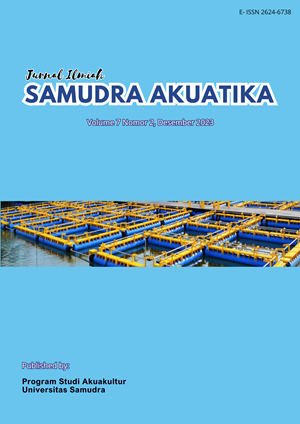Application of Fermented Starfruit (Asam Sunti) as an Antimicrobial in Keumamah Loin
Penggunaan Fermentasi Belimbing Wuluh (Asam Sunti) Sebagai Antimikroba Pada Ikan Keumamah Loin
Abstract
The purpose of this study was to determine the effect of sunti acid on the ALT and mold as an antimicrobial in keumamah loin. The research is experimental and uses a completely randomized design (CRD) with 4 treatments and 3 replications. Treatment 1 was soaking in sunti acid suspension as much as 10% (F1), as much as 20% (F2), as much as 30% (F3), and without immersion (F0). The parameters observed were ALT and mold. The results of these two studies were analyzed using one way analysis of variance (ANOVA) and continued with Duncan's test. The results showed that the highest ALT was in F0 (7.51x105CFU/mL) and the lowest was in sample F3 (6.36x105CFU/mL), then the highest mold value was in sample F0 (7.68x105CFU/mL), and the lowest was in F3 (6.46x105CFU/mL). The difference in the concentration of sunti acid suspension had a significant effect on the ALT and mold on keumamah loin at the 95% confidence interval
References
Brogan DM, & Mossialos E. (2016). A critical analysis of the review on antimicrobial resistance report and the infectious disease financing facility. Globalization and Health 12(1): 1-7.
Hamdanah S, Anam S, & Jamaluddin J. (2015). Isolasi dan identifikasi senyawa flavonoid dari ekstrak etanol buah belimbing wuluh (Averrhoa bilimbi L.) dengan metode spektrofotometri uv-vis. Jurnal Farmasi Galenika 1(1): 22-34.
Hasan H, Anwar SH, & Rohaya S. (2021). Perbaikan desain tungku hemat energi untuk produsen keumamah di Kota Banda Aceh (Design improvement of energy-efficient stove for keumamah producers in Banda Aceh). Buletin Pengabdian: Bulletin of Community Services 1(1): 38-43.
Iqlima A, Dien H A, Kaparang J T, Agustin A T, Timbowo S M, Makapedua D M, & Sanger G. (2019). Pengujian kapang dan bakteri patogen pada ikan kayu (katsuobushi) asap cair selama penyimpanan. Media Teknologi Hasil Perikanan 7(2): 46-51.
Karneta R, Rejo A, Priyanto G, & Pambayun R. (2013). Difusivitas panas dan umur simpan pempek lenjer. Jurnal Keteknikan Pertanian, 1(1)
Katiandagho Y, Berhimpon S, & Reo A R. (2017). Pengaruh konsentrasi asap cair dan lama perendaman terhadap mutu organoleptik ikan kayu (katsuo-bushi). Media Teknologi Hasil Perikanan, 5(1): 1-7.
Kusumawati E, Supriningrum R, & Rozadi R. (2015). Uji aktivitas antibakteri ekstrak etanol daun kecombrang etlingera elatior (Jack) RM SM terhadap Salmonella typhi. Jurnal Ilmiah Manuntung, 1(1), 1-7.
Misrahanum M, Ayuningrum N, & Helwati H. (2022). Uji fitokimia dan aktivitas asam sunti (Averrhoa bilimbi L.) sebagai antimikroba. Jurnal Ilmiah Ibnu Sina 7(1): 155-164.
Nuryanti S. (2017). Aktivitas antifungi sari daun pepaya (Carica papaya L.) terhadap candida albicans. As-Syifaa Jurnal Farmasi 9(2): 1-23.
Nusi T S I, Naiu A S, & Dali F A. (2015). Pendugaan umur simpan abon ikan tongkol asap. The NIKe Journal 3(3).
Octaviani M, & Fadila F. (2018). Uji aktivitas antijamur sari buah belimbing wuluh (Averrhoa bilimbi L.) terhadap jamur candida albicans. Jurnal Katalisator, 3(2), 125-133.
Pulu E K, Dien H A, & Kaparang J T. (2017). Studi keberadaan bakteri patogen pada ikan kayu (Katsuwobushi) yang diproses dengan asap cair. Media Teknologi Hasil Perikanan, 5(2), 48-53.
Ramadani N Y. (2013). Aktivitas antibakterial ekstrak etanol dan rebusan sarang semut (Myrmecodia sp.) terhadap bakteri escherichia coli. Jurnal Medika Veterinaria, 7(2).
Sakti H, Lestari S, & Supriadi A. (2016). Perubahan mutu ikan gabus (Channa striata) asap selama penyimpanan. Jurnal FishtecH 5(1): 11-18.
Sucipto F, & Yuda R. Redesai kemasan ikan kayu cap kapal tsunami. Gorga: Jurnal Seni Rupa, 11(1), 52-59.
Tapotubun A M, Nanlohy E E E M, & Louhenapessy J M. (2008). Efek waktu pemanasan terhadap mutu presto beberapa jenis ikan. Jurnal Ichthyos, 7(2), 65-70.
Yuliana S, Martunis M, & Aisyah Y. (2019). Pengaruh ekstrak daun kari (Murraya koenigii) dalam memperpanjang masa simpan fillet ikan tongkol (Euthynnus sp). Jurnal Ilmiah Mahasiswa Pertanian, 4 (20): 290-299.











